#gintama ed 17
Explore tagged Tumblr posts
Video
youtube
SPYAIR 『サムライハート (Some Like It Hot!!) - New Version -』Music Video
15 notes
·
View notes
Text

Gintama OP/ED Song Tournament
"Speed of Flow" is the 8th ending theme (episodes 88-99).
"Kagerou" is the 18th opening theme. It is the 1st opening song for Gintama. (episodes 317-328).
Songs under the cut.
youtube
youtube
8 notes
·
View notes
Text
Gintama Ending Themes poll (2/3)
16 notes
·
View notes
Text
10 songs, 10 people
Thanks for tagging me @ninhaoma-ya )
Put your music on shuffle and list the first ten songs that come up, then tag ten people
Король и Шут - Тяни!
Stuart Chatwood - Trouble in the Barracks (OST from one of the Prince of Persia games)
Yasuharu Takanashi - Rengougun, Shuuketsu! (Fairy Tail OST)
Maon Kurosaki - Scars (one of the Hellsing Ultimate EDs)
JAM Project - Seijaku no Apostle (One Punch Man Season 2 OP)
Король и Шут - Ели мясо мужики
Spyair - Wadachi (song featured in Gintama The Final movie i think)
Blackmore's Night - Castles and Dreams
Linkin Park - Easier to run
Yasuharu Takanashi - Mahou Taisen (Fairy Tail OST)
Tagging @sukehiroseleii @kstarlitchaotics @otaku-daydreamer-4673 @shampooneko @behemocoatyl @foxy-17 @gruviasilversblog @gruviasama @fbflame94 @natsu-scarf
6 notes
·
View notes
Text
Gintama Endings - Easter Eggs + Other Things




Ed 4 - The yellow よいこのこくご ("Japanese for Good Kids") book Gintoki's holding is the same one Nobume studies from later in the series.
Hasegawa's looking through a magazine titled アルバイト ("part-time jobs").
The kanji practice is all 糖分 ("sugar content").

Ed 9 - He wrote いちご ("strawberry") with the sakura petals.

Ed 10 - Sa-chan's sign says 銀さんへ ("For/To Gin-san <3").
The concert sign says 寺門 通 - サマーフェスタ ("Terakado Tsuu - Summer Festa")

Ed 14 - Gintoki's bowl says 銀ちゃん用 (basically "for Gin-chan to use").
The empty bag Shinpachi's holding is for rice (米).

Ed 17 - 松陽 ("Shouyou") is written on the sign.

Ed 28 - Despite everyone wearing wedding attire, the cake says 神楽ちゃん、おたんじょうびおめでとう ("Happy birthday, Kagura-chan")

Honorable Mention: Zura and Eli T-posing in Ed 1
82 notes
·
View notes
Text
Academic texts about Shinsengumi: Lee, Rosa (2011)

'Moeyo ken' and its Hijikata character
Reference: Lee, R. (2011). Romanticising Shinsengumi in Contemporary Japan. In: Dr Suter, Rebecca (Ed.), New Voices in Japanese Studies, Vol. 4 (pp. 168-187). The Japan Foundation, Sydney. http://dx.doi.org/10.21159/nv.04.08.
This text claims that the contemporary portrayals of the Shinsengumi in Japanese pop culture mostly stem from the popularity of and/or share similarities with the novel “Moeyo ken” by Shiba Ryōtarō. The author Rosa Lee here on one hand analyzes amazon reviews of the novel, on the other hand compares “Moeyo ken” with “Gintama”.
Since there seems to be no English translation of this novel, I decided to share with you contents of it that are discussed in the paper.
Also, I think this academic text partially explains why Hijikata has the BY FAR longest route in Hakuōki and why he is the focus of the game's marketing.
(Warning: Wordy text)
Locating Popular Imagination of Shinsengumi (pp. 170-72)
“No other text is more appropriate than Moeyo ken to extract the archetype imagination of Shinsengumi in postwar Japan. Firstly, the novel was voted as the best fictional representation of Shinsengumi in a 2003 magazine survey.10 Secondly, perception of Shiba’s Shinsengumi as a close reflection of the actual figures is such widespread that whether or not they decide to follow Shiba, post-Moeyo kenreproducers of Shinsengumi cannot ignore his rendition when formulating their own versions.11 Shiba’s influence must be considered in the context of his reputation as a prominent national writer.12 Being perceived as ‘someone who can accurately communicate the realities of Japanese history rather than…a mere fictionwriter’,13 his characterisation of Shinsengumi transcends fictional boundaries and becomes a reality for many Japanese. In fact, one historian laments many texts place emphasis on Hijikata Toshizō, the vice commander of Shinsengumi, or Okita Sōji, the captain of the first unit, instead of Kondō Isami, the actual head of the organisation, because Shiba’s characterisations of Hijikata and Okita are overwhelmingly popular.14
Taishū bungaku as a Mirror for the Masses’ Philosophies of the Age
To comprehend why Shiba’s heroes are popular, this article will first examine the implications of Moeyo kenas a taishū bungaku. Originating from kōdan or historical romances for commoners, taishū bungaku is rather ambiguously distinguished from junbungaku (pure literature).15 It is argued that the term was initially adopted in the early 1920s to differentiate works from pure literature as well as from the more vulgar fiction.16 Thus labelling a work as taishū bungaku did not necessarily connote that it was non-serious or even commercially popular.17 Nevertheless, the two genres became qualitatively differentiated as authors of junbungaku were considered ‘artists’ in contrast to their ‘artisan’ counterparts.18 This division was further solidified with the creation of separate literary awards for each style.19 However in recent years, postwar economic expansion, development of mass media, writers’ shift from one genre to another and a new generation of writers’, such as Murakami Haruki’s, experiment with postmodernity have further challenged the definition of pure and popular.20
For our purposes, it is sufficient to note that authors of junbungaku wrote more ‘for the sake of other writers’21 and were ‘withdrawn from concerning themselves with political and national affairs’.22 In contrast, taishū bungaku has traditionally been ‘absorbed and reflected by the masses through entertainment’.23 That is, popular literature exists precisely because the masses consider a work entertaining. Form, content and target audience of taishū bungaku have fluctuated across time as authors try to adapt to changes in the readers’ environment and perception. In this respect, readers are indirectly contributing to the creative process as writers attempt to meet the demands of their audience.24 Yet, the authors’ determination to entertain readers continues to be a key characteristic of the genre.25
According to Antonio Gramsci, entertainment in this context denotes more than amusement.26 Entertainment distilled in popular literature is ‘an element of culture’ as it adheres to changes in ‘the times, the cultural climate and personal idiosyncrasies’.27 These elements are produced through a careful calculation to make a novel successful by appealing to the moral and scientific ‘philosophy of the age’: the deeply embedded ‘feelings and conceptions of the world predominant among the “silent” majority’.28 Heroes in popular literature are thus able to attract readers because their narratives reflect the masses’ ideals.
On this basis, it may be possible to locate a ‘philosophy of the age’ by examining how and why readers are attracted to heroes of successful taishū bungaku. This requires a consideration of who constitutes as the ‘silent majority’ in postwar Japan. Postwar taishū bungaku became more sophisticated and diversified as authors began to adopt a more realistic, informative or both styles of writing.29 Concurrently, its readership expanded from the existing readership of female readers and blue-colour workers, to include the emerging middle class, intelligentsia dissatisfied with the status quo and white-collar workers.30
Furthermore, in the age of economic expansion and commercialism of literature, writers of popular literature such as Shiba managed to ‘appeal to some hundred thousands of readers’ by successfully distilling in their works values shared by the masses, or by ‘at least giv[ing] the masses that impression’.31 Readership of taishū bungaku, or at least Shiba’s works, could therefore be described as a large group of people from various backgrounds, connected by their attraction to a work of fiction embodying their values. In other words, the ‘silent majority’ could be considered as a reflection of the Japanese public.32
If the hero in Moeyo ken is our key to deciphering the masses’ consciousness, how do we identify the elements of entertainment distilled in him? This requires a scrutiny of how readers locate their own model heroes and compasses since the entertainment value of a work is ultimately judged by the audience.33 For this purpose, the practice of ‘sequel-writers’ who ‘revive’ and ‘recreate’ heroes of successful popular fiction with ‘new material’ is noteworthy since modifications are made to accommodate changing social sentiments.34 We may therefore discover why the masses are drawn to Shinsengumi by comparing Shiba’s heroes in Moeyo ken, the prototype of contemporary representations of Shinsengumi, with its reproductions. In turn, this could elucidate the underlying reason for popular romanticisation of Shinsengumi in contemporary Japan.”
Scope of Study
This section is about Lee’s methodology in her study. She notes here:
“(...) [A] caveat must be imposed that in examining representations of Shinsengumi in Moeyo ken and Gintama, this article will consider the authors’ renditions of Hijikata Toshizō as reflecting the public’s perception of Shinsengumi as a whole. Not only is Hijikata the main protagonist of Moeyo ken and a major supporting character in Gintama, he also appears to be popularly appreciated as the epitome of Shinsengumi, the embodiment of its values and virtues. As noted previously, most Shinsengumi-related texts are focused on Hijikata, even though he is only the vice commander. The public’s adoration of Hijikata is also reflected in NHK’s broadcasting of Shinsengumi!! The Last Day of Hijikata Toshizōas a sequel to the taiga dorama (grand fleuve drama), ‘Shinsengumi!’.40 As a particular genre of historical narrative that ‘encourages and integrates present Japan by remembering and celebrating the past’, taiga dorama influences, and is influenced by the zeitgeist of the Japanese society..41 Like heroes of popular fiction, popular taiga dorama heroes exhibit values which resonate with the Japanese public.
However, in the case of Shinsengumi!, it is arguable that NHK’s representation of Shinsengumi was insufficient to satisfy the public’s longings.42 The drama series was focused on Kondō, the head of Shinsengumi, and ended with his execution. Thereby Hijikata’s subsequent struggles against the new government were omitted from the series. However, viewers’ persistent demand forced NHK to eventually produce an unprecedented sequel about Hijikata’s final days in 2006, two years after the original taiga dorama was broadcast.43 This vignette reveals that Hijikata Toshizō is critical to complete popular romanticisation of Shinsengumi. Focusing our scrutiny onto Hijikata would therefore be more productive than canvassing different Shinsengumi members or reducing Shinsengumi into a single identity.” (pp. 173f.)
Toshizō: an Archetype of Real Japanese Men (pp. 174-76)
“Before we probe the readers, let us first consider the hero of Moeyo ken, Hijikata Toshizō (1835~1869), who will be referred to as Toshizō to distinguish the fictional character from the actual person or other versions. He is another archetype of Japanese men idealised by Shiba, whose view of male aesthetics concedes that a real man dies for his ‘risei to kigai (reason and spirits) as opposed to ideologies and discourses’.46
Toshizō’s reason and spirits lie in the determination to accomplish his aesthetics as a kenkashi, a fighter, rather than the more sophisticated and chivalrous samurai or shishi. The protagonist moves from the outskirts of Tokyo to Kyoto in response to the Bakufu’s recruitment of the shogun’s bodyguards. Together with his friends, Toshizō soon becomes the backbone of Shinsengumi, a Bakufu protection squad consisting of men from various classes and walks of life.
Having appointed himself as the vice commander, Toshizō successfully disciplines and organises the group into a powerful military corps by adopting makoto (sincerity) as trademark and adopting Kyokuchū hatto, a strict code of conduct attracting seppuku if violated. Such stern determination and ruthlessness award Toshizō with notoriety as the demonic vice commander among residents of Kyoto and his enemies. Concurrently, Shinsengumi’s reputation also peaks with a successful raid on a secret jōi shishimeeting at the Ikedaya Inn.
But their glories are short-lived as Shinsengumi descends alongside the Bakufu’s downfall. Kondō’s execution is ordered by the new government and many core members also perish in battles. Nonetheless, Toshizō and remaining members continue to fight against the forces of the Meiji Restoration and even join the movement to establish the Republic of Ezo in Hokkaido.
Toshizō, now the republic’s deputy minister for military, continues to be driven by his aesthetics as a fighter. Contrary to other ministers seeking to surrender to the new government, he charges out for the last time to fight his enemy. When an opponent soldier demands his identity, Toshizō, after deliberating for a moment, declares himself as not the deputy minister of the Ezo Republic, but as the vice commander of Shinsengumi. The stunned soldier questions Toshizō’s intention, only to become further baffled when our hero proclaims, ‘I believe I have already stated my agenda. If the vice commander of Shinsengumi has a reason to visit the opponent’s Council of War, it is because he seeks to slash the members of the Council’.47 These become Toshizō’s last words as he falls from the soldier’s gunshots. Thus an end comes to the tumultuous fate of Toshizō and Shinsengumi, and to their fleeting yet blazing appearance in Bakumatsu Japan.
As a text, Moeyo ken is open to numerous interpretations. To readers familiar with classic Japanese tragic heroes such as Minamoto no Yoshitsune, Toshizō may appear as another noble, but failed hero.48 On the other hand, the close intertwining of Toshizō’s life with Bakumatsu history may inspire others to read it as a nationalist discourse about an ambitious, youthful hero whose life merged with the making of the Japanese nation like Sakamoto Ryōma.49 That is, Shinsengumi as depicted by Shiba could be tragic heroes, exemplary Japanese citizens, charismatic individuals, all at once or none of these. Although interesting, these interpretations do not explain Shinsengumi’s popularity as they are no more than fragmented speculations, void of voices of the actual fans ‘who appropriate popular texts and reread them in a fashion that serves different interests’.50 Discovering why this particular characterisation of Hijikata Toshizō is admired necessitates an inquiry into popular perception.”
Readers’ Imaginations of Hijikata Toshizō
Lee later on analyzes amazon reviews of Moeyo ken with a focus on readers’ perceptions of Toshizō. This is what she found:
“Out of 152 reviewers identified, 149 uploaded positive reviews as only three awarded Moeyo ken three stars or less, and 103 reviewers commented on Hijikata’s characteristics. At the end of the third stage of analysis, readers’ views of Hijikata could be categorised as follows:
a) a tragic hero,
b) someone who makes the reader proud of being Japanese,
c) a self-determining individual,
d) an attractive individual because he is kakkoii (cool), heroic or antiheroic without further elaboration of these descriptions,
e) a person with a likeable personality (e.g. being humane, empathetic, down-to-earth and/or straightforward),
f) a man of integrity,
g) a talented individual, and
h) others.
The first three response categories were adopted to check if a response corresponds to likely approaches to reading Moeyo ken previously canvassed in the article. The latter were established after two counts of review analysis to make a coherent synthesis of the responses.” (p. 182)
Here are the percentages:
c) Self-determining person; 64.1%
d) Attractive person; 22.3%
e) Likeable personality; 12.6%
f) Man of integrity; 14.6%
g) Talented individual; 9.7%
h) Others; 4.9%
a) Tragic hero; 4.9%
b) Proud Japanese; 1.9%
“Strikingly, 64 per cent of reviewers described Hijikata as a self-determining person. Considering they could have characterised him in any manner, the majority’s identification of Hijikata as a self-driven individual indicates reviewers consider this characteristic as his defining feature. A reviewer, Sūjī, quotes Toshizō’s words as his or her own philosophy on life:
‘To Live
“The times are not a matter of concern. Victory and defeat also need not be discussed. A man must follow his envisioned aesthetics to the grave”.
The words Hijikata Toshizō cast on Kondō Isami, words which also continue to torment me.’68
Many readers appear to agree as 21 out of 23 users rated this review as useful. Others also similarly note that they view Hijikata’s life as ‘a compass for life’, or that they could re-evaluate ‘everything within [their selves], including the course of life and personal values’.69 Not only do these responses reflect the nature of popular literature as a reflection of one’s ideals, they confirm Hijikata is popularly imagined and loved as a hero driven by self-determination.” (pp. 182f.)
QUESTION for all of you: What do you think defines Hakuōki’s Hijikata the most?
#hakuoki#hakuouki#academic texts#academic texts about shinsengumi#academic texts about hakuoki#moeyo ken#hijikata toshizo#hijikata toshizou#pls don't sue me#i listed the source correctly#what do you think defines Hakuoki's Hijikata the most?#for me it's his self-determination
3 notes
·
View notes
Note
what are your favorites anime opening and ending ?
hey there, anon!! i hope you are doing fine! woahh i really like many ops and eds, so i’m gonna list my top 5 for each one!
openings:
sakuramitsutsuki, spyair - gintama op 13;
i wanna be, spyair - gintama op 21;
hello, world!, bump of chicken - kekkai sensen op 1;
diver, nico touches the wall - naruto shippuden op 8;
mukanjyo, survive said the prophet - vinland sanga op 1.
endings:
some like it hot!!, spyair - gintama ed 17;
possibility, sanagi - gintama ed 9;
fighter, bump of chicken - sangatsu no lion ed 1;
shura, does - gintama ed 5;
tenchi gaeshi, nico touches the wall - haikyuu ed 1.
ok gintama has one of the best ost out there ♥ also i really like these bands a lot, so yeah o//
send me “what’s your favorite..” asks 💫
#anonymous#also omg guys pls listen to wadachi - spyair#the lyrics are just ♥#love it so much!!#can't wait for gintama the final <3
18 notes
·
View notes
Note
ohhhhh boy okay uh! Only Wonder by frederic slaps, and I use Ship In A Bottle by fin whenever I need to drown stuff out. The only YouTube series I’ve really been following lately has been hermitcraft (specifically mumbojumbo) but I understand if you’re hesitant to get involved with mcyt content again.
The only other music that really comes to mind…. Boy it’s probably gonna make it pretty easy for you to guess who I am, but a lot of the gintama op’s and ed’s slap. My personal favourites are opening 9, opening 13, opening 14, opening 20, and opening 21, although of course a couple of the later ones include series spoilers if you plan on watching the videos.
uhm, as for the endings,,, ending 2, ending 8, ending 17, ending 21 and then endings 25-30 all slap. There’s also Yorinuki Gintama-San, which are new openings/endings they did for reruns. they’re all good :)
Ok so ive been sitting on this ask for a few days while I go through all the music recs I got. I have played ship in a bottle on loop for nearly 2 hours. That slaps. Honestly I love how you hear the ukulele throughout every moment of the song? Like idk ive always liked that instrument and even tho it's not super prominent at certain points it is very nice for it to be backing support as well :) I think it adds a little charm to it!
Also yeah I just kinda avoid the mcyt fandom for the most part but I do watch some hardcore series still! Might try hermitcraft at some point but I really dont have much time to watch series or anything, rip. I'm probably only on YouTube like twice per week lmao
Also! I listened to like half of the gintama ops and eds you listed, still have some to try out but I figured I'd release this ask into the wild since ive been holding it captive for a while anyway. Lots of those go really hard. Like damn ok I saved a few to my 'bops' playlist ngl
1 note
·
View note
Text
My ranking of favourite blood-related anime siblings (from most to least liked)
1) Kimetsu no Yaiba - Kamado Tanjiro & Kamado Nezuko (no one can replace Tanjirou as BEST BIG BROTHER EVER. This anime is a heaven-sent)
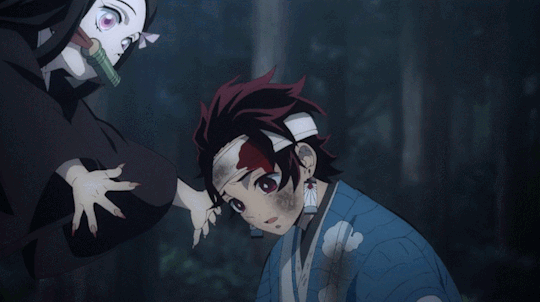
2) K-On - Hirasawa Yui & Hirasawa Ui (purest sister bond you’ll ever see in an anime)
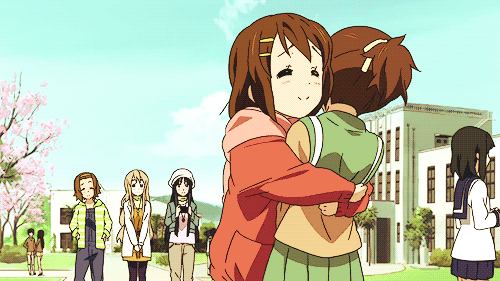
3) 3-gatsu no Lion - Kawamoto Akari, Hina & Momo (wholesome family bond)
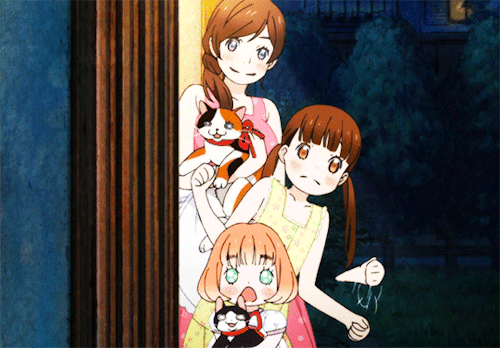
4) Fullmetal Alchemist Brotherhood - Edward Elric & Alphonse Elric (it’s in the title. Their strong brotherly bond can defeat everything that comes for them)

5) Naruto - Uchiha Itachi & Uchiha Sasuke (when you say anime siblings, one of the first names that should come up is the Uchiha brothers. Some may disagree with Itachi’s actions but he loves his baby brother the most in the world)

6) Ao no Exorcist - Okumura Rin & Okumura Yukio (sometimes I forget that they’re twins because they both have such different personalities but even when they clash, you know they care about each other)
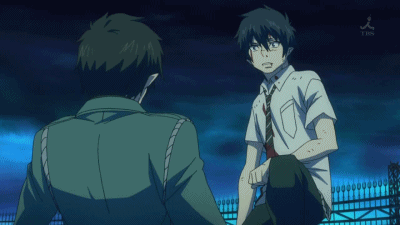
7) WWW.Working!! - Takanashi Souta, Kazue, Izumi, Kozue and Nazuna (I LOVE watching these siblings interact. Responsible Souta having to take care of the house and his sisters even though three of them are older than him. FUN)
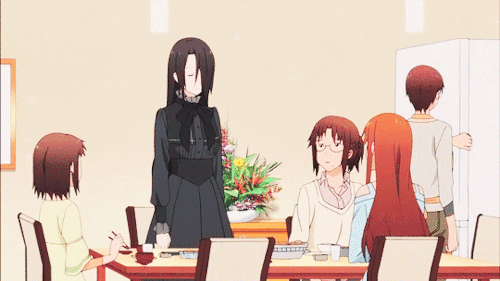
8) Osamatsu-san - Matsuno Osomatsu, Karamatsu, Choromatsu, Ichimatsu, Jyushimatsu, Todomatsu (everyone’s favourite sextuplets. What more can I say? You either love em or hate em)
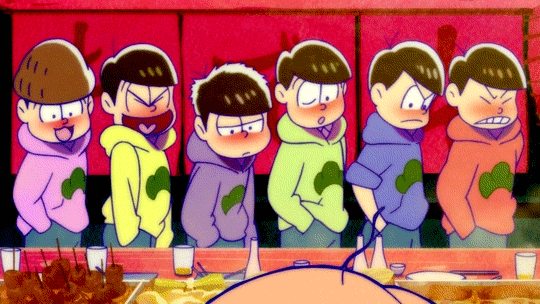
9) Ouran High School Host Club - Hitachiin Hikaru & Hitachiin Kaoru (most famous anime twins ever? Amirite? Best comedy duo, well trio if you add Tamaki)

10) Charlotte - Otosaka Yu & Otosaka Ayumi (I know they have an older brother, Shunsuke but I like these two’s relationship more. You don’t wanna mess with best imouto or the oniichan will kill you)
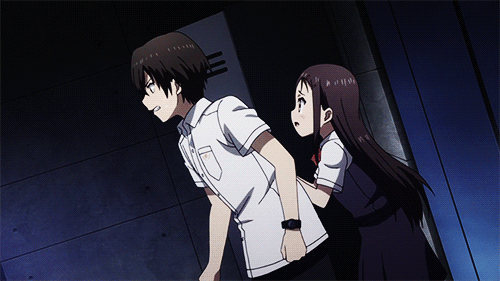
11) Naruto - Temari, Gaara & Kankuro ( they were fearsome when they were kids. I legit was afraid of them but as the story progresses, they grew on me)

12) Koe no Katachi - Nishimiya Shouko & Nishimiya Yuzuru (the younger sister protecting the deaf big sister melts my heart uwu)

13) Code Geass - Lelouch vi Britannia & Nunnally vi Britannia (idk what else I can say, the dude literally did everything he could just to give his sister a better world to live in)

14) Ao Haru Ride - Tanaka Kou & Tanaka Yoichi (you’d be lying if you didn’t aaaw-ed at that scene when baby Kou was crying in his brother’s arms)

15) Boruto: Naruto the Next Generation - Uzumaki Boruto & Uzumaki Himawari (he’s such a sweet big brother to Hima)
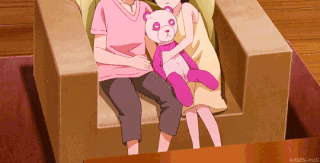
16) Seishun Buta Yarō - Azusagawa Sakuta & Azusagawa Kaede (it’s cute and sad how clingy she is with her brother due to her syndrome. He tries his hardest to be a good big brother and she too did her best to recover so that he won’t feel sad anymore)
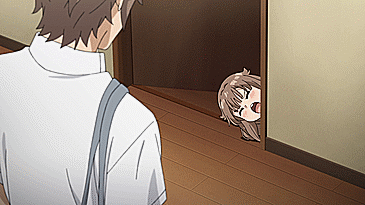
17) Clannad - Fujibayashi Kyou & Fujibayashi Ryou (that heartbreaking scene when they both basically got rejected by the same guy and started crying, uggh my heart)

18) Doraemon - Doraemon & Dorami ( not blood-related but more like oil-related lol since they both drank from the same oil can. They’re both the cutest)
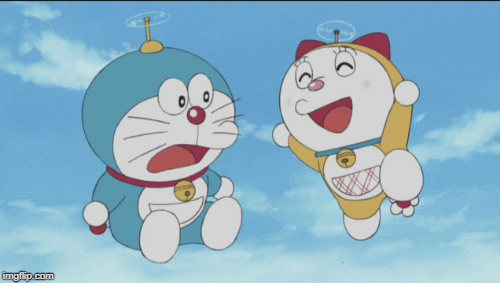
19) Mob Psycho 100 - Kageyama Shigeo & Kageyama Ritsu ( I haven’t watched this anime yet but I really like these two?)
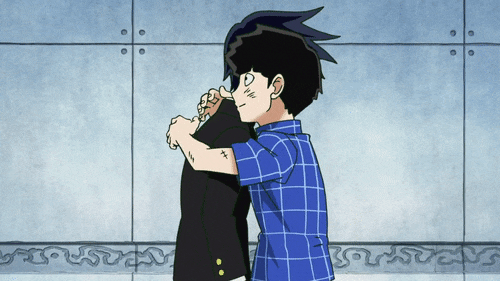
20) Cardcaptor Sakura - Kinomoto Touya & Kinomoto Sakura (I hate Touya so much when I was a kid because he was just like my brother who likes to tease and bully me. Never really liked him still but I appreciate his way of trying to protect sakura, no matter how annoying he is)

21) Re:Zero − Starting Life in Another World - Ram & Rem ( another pretty famous twins in the anime world. I don’t hate them nor do I like them but they’re okay)
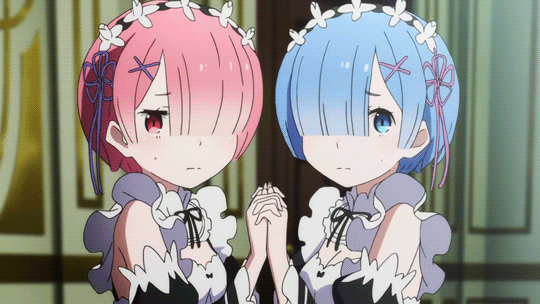
22) Durarara!! - Heiwajima Shizuo & Heiwajima Kasuka (I like them but they weren’t really my main focus of the anime)

23) WWW.Working!! - Yamada Kirio & Yamada Aoi (they’re so annoying. In a fun way. lol)
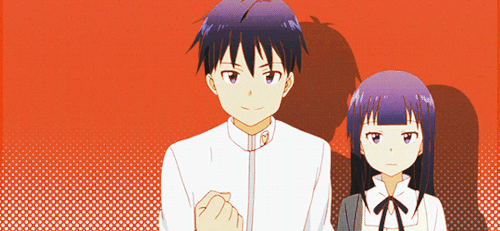
24) Naruto - Hyuga Hinata & Hyuga Hanabi (I’m indifferent with Hinata but I liked Hanabi back then and was so sure that the manga would include her more but LOL)
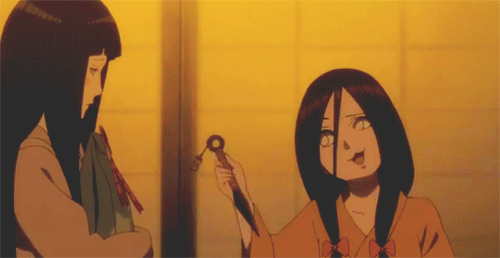
25) Gintama - Shimura Shinpachi & Shimura Tae (I don’t watch Gintama properly. I skip a lot of episodes and only watch some arcs when I feel like it so I don’t know much about these two except that they do love each other)

26) Durarara!! - Orihara Izaya, Orihara Mairu & Kururi (not fond of the twins. Am fond of Izaya)
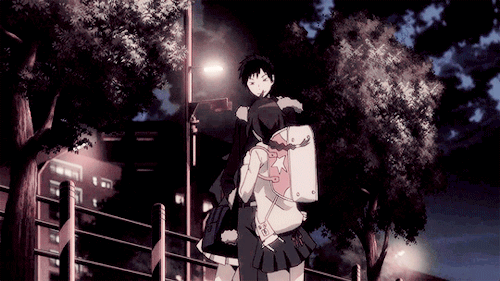
27) Gintama - Kamui & Kagura (like I said, I don’t watch Gintama properly and I’m not planning to watch it in order but I actually like these two as individuals)

28) Kyoukai no Kanata - Nase Hiroomi & Nase Mitsuki (his imouto fetish is annoying as hell. this anime is far from perfect but I enjoyed it nevertheless)
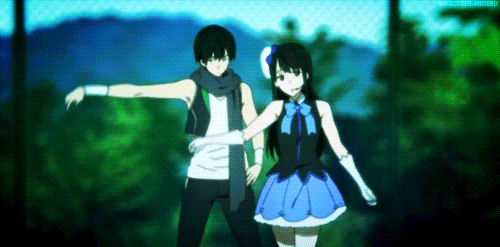
#demon slayer#kimetsu no yaiba#tanjirou kamado#nezuko kamado#naruto#uchiha sasuke#uchiha itachi#edward elric#fma#alphonse elric#brothers#sisters#anime#siblings#gintama#kamui#kagura#shinpachi#kyoukai no kanata#charlotte#kinomoto sakura#kinomoto touya#ao no exorcist#okumura rin#okumura yukio#takanashi souta#hyuga hinata#hyuga hanabi#rem#ram
5 notes
·
View notes
Note
16 or 17 for the fandom asks thing, except replace “hate” with “dislike” or “didn’t particularly care about” I guess, if saying “I hate(-d) it” would be too much :)
Thank you for asking!!! I’m going to answer both and also yeah, hate is really too strong of a word.
—
16. Favorite villain/s.
—
This is so fucking hard. I’m going to cry kfhdjkghdf. Let’s go by some fandoms.
Bungou Stray Dogs: Fyodor. I can’t even understand why I think it’s just because if you think about it enough his character is just batshit crazy. And it’s not really creepy in a Mori-way? Dangerous batshit insane but not creepy, yeah.
I don’t really see the Port Mafia or The Guild as villains anymore, having caught up to season 3, but if I had to say, Chuuya. It’s Chuuya, okay.
Naruto: Ehh, the whole Akatsuki is pretty much likable despite being bigass assholes. But in general, Sasori. You don’t get it, I bought a Naruto volume with 640 sites because it got the whole chapters of Sakura’s and Sasori’s fight. I’m not okay, okay. I really like Nagato and Konan too! Konan’s just amazing and in the end, if Nagato didn’t turn the path he went, he could have been an even more interesting character. Obito too!
And yeah, Kabuto. I said it, Kabuto. He’s a big asshole but I think I really liked his character in a sense, probably because a big part of himself was confused with himself in a sense.
Natsume Yuujinchou: Matoba Seiji is one of those interesting kinds of villains. He also gives me Kabuto vibes. Hmm, and I know he isn’t supposed to be a villain but Natori Shuuichi. I know he cares about Natsume but some episodes he gives me more villain vibes than Matoba.
Durarara!!: Yep, the antagonist of Durarara, Izaya! He’s fun to watch, so...
Gintama: DSHJKFHSDJFHSDJFKHSD I cry dude, Kamui.Yeah, kind of like Izaya.
Fullmetal Alchemist: The Truth. Truth’s the middle ground in a sense, they are not really evil or good: They are also not the antagonist of the series but I think about it like this: Ed is in a constant battle against the Truth for a long time, thus I see them as an antagonist anyway. I really love how they approached Truth, which is why I count them as a fave.
—
17. A show you used to love but eventually disliked or vice-versa.
—
I don’t really think that happened. At least not in the way the question seems to portray it.
Take Naruto as an example: I don’t dislike the series itself but I do not like where it went which is why I don’t cherish it as much as I used to. I can’t even really call it one of my faves that much anymore. I still love the characters, which is why it’s easy to read fics. But watching the show for its plot? Mhn, not really. For memories maybe.
I guess the opposite would be Fairy Tail. But like, I disliked it before I even watched it, which is why I don’t really count it. I admit back then it was easy to write Fairy Tail off as some harem anime... yeah, I changed my opinion quickly after watching it. I also learned not to judge anime slowly based on their cover pictures.
Hatenkou Yuugi... I still really like it but I admit after reading the manga I started to dislike it a bit. Not much, I still love it, but I guess the direction in where the plot went wasn’t just my cup of tea.
But that’s the thing, I don’t really start to dislike any anime? It’s more like... I just started caring less about them or not really caring at all. If someone mentioned them I’d still have fond memories of watching the anime but I wouldn’t care as much as if when I’d talk about Bungou Stray Dogs.
For example, Kami-sama no Inai Nichiyoubi... I don’t like the plot, I’ll admit but the anime itself? Still likable just not as much when I watched it. I don’t really look its tags up anymore. It was a good watch for me though.
Same for Kamikaze Kaitou Jeanne.
Ah, but there is one anime I started to dislike tho. Karin. Yeah, it was okay until the fucking end. It was.
3 notes
·
View notes
Text
Ranking the Gintama OPs
21 OPs is a lot of OPs. And if there’s one thing the internet has taught me, it’s that when there are a lot of things, the best possible course of action is to rank them. So that’s what this is: my very biased thoughts on each of the Gintama OPs, and how they stack up against each other. I might do another one of these for the EDs at some point, although probably not tonight; my hand’s cramping enough as it is. Here we go!
21: Katte ni My Soul (OP 20)
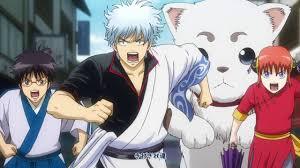
The Silver Soul arc was the true beginning of the end for Gintama, the final chapter that’s currently extending into its extended epilogue. It’s the grand finale for one of the biggest, most sprawling stories ever written... so why did its first OP end up feeling so limited? While I do like the song, there’s almost no sense of the grandeur or excitement such an important finale would entail. No big battle scenes, no real sense of scope, no indication of the massive, electrifying war for Edo encompassing the entirety of this show’s massive cast that this OP is supposed to get us hyped for. This should have been a slam-dunk explosion of badassery; instead, it was just kinda meh and uninspired. What a damn shame.
20: VS (OP 19)

In all honesty, it’s not entirely the OP’s fault that it ended up so low on the list. The Slip Arc was an intentional return to the classic, low-stakes, pre-Shogun-Assassination Gintama that defined it for so many years, and the OP reflected that breather mentality by being a deliberate throwback to the looser, lighter style of assorted comedic hijinks that makes up the “classic” Gintama OP style. It’s enjoyable enough, and the colorful comic strip styling is pretty neat. But compared to the competition, it just doesn’t do enough new with its concepts to fully justify the return to form. Gintama’s done everything in this OP before, and it’s done it all better.
19: Silver Sky (OP 3)

I really wanted this one to be higher on the list, just on the strength of its song. Giniro no Sora is a really beautiful mellow rock jam that captures the blissful, pleasant side of Gintama really well, and the op reflects it beautifully with its low-key visuals and relaxing tableaus of the Odd Jobs crew just hanging around and living their lives. In the end, though, there isn’t that much cohesion in the visuals, no real story being told or overarching emotion being expressed. I still enjoy it a lot, there’s just not much going on on a deeper level.
18: Pray (OP 1)

It’s a pretty good sign that Gintama’s first OP ended up so low down on the list. This is a show that’s constantly improving on itself, after all, and its OPs have only gotten better to reflect that. That said, while Pray is a little bare-bones as a result of being the first time a lot of these images and themes were first used, it still uses them very well, conveying the excitement of the start of this new adventure with its snappy, attitude-driven character introductions, while still finding room to hint at the narrative’s more dramatic undertones as Gintoki faces down a horde of zombie soldiers representing the fears and regrets of everything he’s left behind. It’s a simple start, but every journey begins with a single step.
17: Tooi Nioi (OP 2)
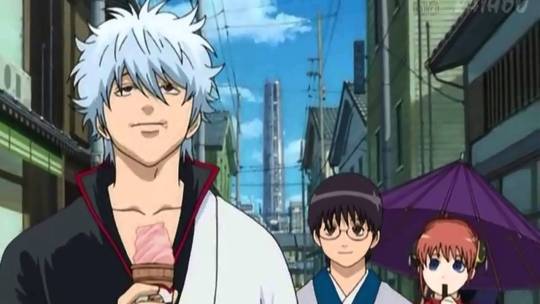
This essentially does the same thing that Silver Sky does, focusing on the Odd Jobs family’s daily life and the assorted randomness of the world they live in. What makes this one better, in my opinion, is that there’s a far more defined edge to the aspects we’re exploring I remember so many individual moments from this OP, from Gintoki’s strawberry ice cream to Kagura’s hopscotch game to Takasugi’s sinister ascension from a cloud of flames. You get a sense of just how comfortable this world is, but also how wild and unpredictable it can be. Overall, it definitely feels the most alive out of the first crop of Gintama OPs.
16: Beautiful Days (OP 16)
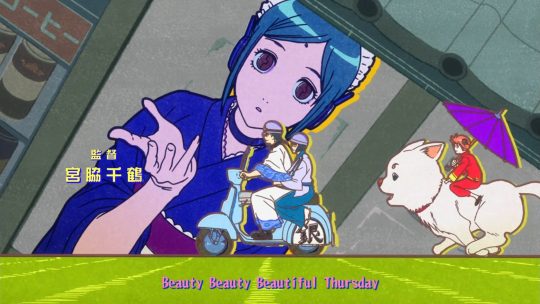
This OP was saddled with a particularly unfair burden in that it needed to act more like a relaxed, inconsequential ED, to contrast the pulse-pounding intensity of its actual sister ED Glorious Days. Thankfully, it managed to step up to the plate and be the best possible version of itself it could, painting an appealing pop-art vision of the Gintama universe that makes it look just as colorful and bouncy as it feels. I adore the playfulness of the animation, especially during the counting leading up to the chorus, and the song itself is goofy enough to match. It’s got plenty of attitude to spare for such a small package, and that’s more than enough for me.
15: Donten (OP 5)
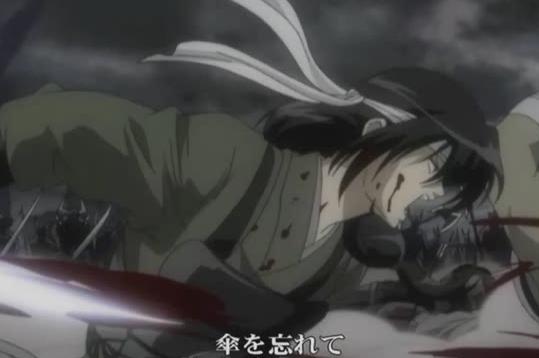
The first time a show like Gintama goes full badass is a moment that sticks in your mind forever. That’s true of the story itself and its OPs, and while Donten has been surpassed by future endeavors, it still packs one hell of a punch. With its moody, rain-soaked atmosphere, pulse-pounding hard rock jam, and intense cinematography, this was the perfect OP to foreshadow the equally blood-racing Shinsengumi Crisis arc, and just overall a really riveting watch. I especially love the moment in the middle of the verse where the editing matches the beat of the music, cutting between various players with perfect timing. And the final, extended shot of Gintoki and his family shaking off the horrors they’ve been through by staring at the brilliant sun up above? Goddamn, that’s powerful stuff.
14: Day x Day (OP 14)
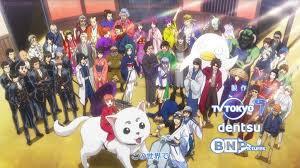
Where this OP excels is selling the magnitude of Gintama’s world. The framing device of the motorcycle ride through Edo, inadvertently sweeping the entire cast up in its wake, before transitioning into the chorus as a city’s worth of supporting players big and small alike cascade through the sky, makes this universe feel as massive and interconnected as it has every right to be. Add to that a fantastic song and some killer moments of comedic timing (Zenzo’s poor ass), and Gintama’s third season started off on one hell of a high note.
13: Let’s Go Out (OP 12)
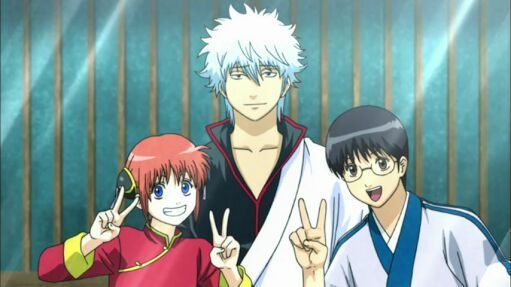
Goddamn, this OP deserved so much better than a single play. Once Kintoki’s face was knocked off the frame, taking his uncomfortably-pleasant presence with him, this OP became a really stellar example of the classic Gintama OP. The fantastic character intros (I live for Kagura cuddling Sadaharu), the image of the oak seed pods making for a strikingly original visual motif, Gintoki running across the fields of his past and into the future, that final, goofy shot, one of my favorite songs of the bunch... yeah, this one’s a real winner. Now if only it actually played in front of a single episode.
12: Anata Magic (OP 6)

This OP is proof positive of just how much difference the details can make. While the visuals are all pretty standard Gintama OP fare, the fantastic character animation and whipcrack-tight editing make it feel like an adventure. From dropping in on the Odd Jobs house to the chillingly striking villain poses and everything in between, this OP is bursting with personality and verve, aided by a rollicking song that makes every image pop with life. It might not match the immensity of the arc it’s building towards, but I never regret getting pulled along its journey.
11: Light Infection (OP 8)
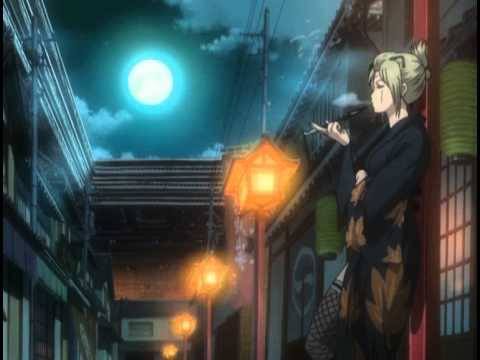
I’ll admit, it took me a while to warm toward this one because I didn’t really like the song initially. But the more I sat with it, the more its moody, driving echo really struck a chord with me. This OP is dripping with the weight of the characters’ pasts, the regrets they carry with them, the hopes they leave behind. And there are so many singularly striking shots: the opening dive following the crows down to pick the battlefield clean, watching everyone’s past transition into their future, Gintoki running through the scarred fields of battle as time catches up to him, the blazing red of the sunset... this OP isn’t just intense, it’s stirring, and it makes you feel the darkness driving its character so fucking perfectly.
10: Kasanaru Kage (OP 4)

This is the moment where the Gintama OPs really came into their own, remixing their established symbols and techniques into something that really struck a chord with me. The opening shots of everyone lost in the moments of their past transitioning into them rushing across the sunlit fields of their new life as the song kicks up is a perfect moment of character establishment, and Kyubei’s haunting introductory flurry of blades sets them up beautifully. But it’s the song that really makes this one, powerful and resonant in a way that’s hard to pin down with words, but sticks with you all the same. This was the first OP that really got me into these characters’ headspaces, and it’s stuck with me ever since.
9: Pride Kakumei (OP 15)

Part of me wonders if I’m being a little too kind to this OP. The editing isn’t particularly inspired, and there aren’t that many setpiece moments. But goddamn, does it makes me happy every single time I watch it. The soaring ballad of the song is the perfect accompaniment to this cavalcade of all the warmth Gintama has to offer, from the fantastically fuzzy festival scene at the beginning to Sachan’s melancholy rooftop fireworks viewing to that killer montage of Gintoki’s past flashing by his mind in snapshots as he breaks into a run, reaching for the chaotic explosion of life that takes over the song’s final stretch. This OP captures how happy Gintama makes me feel, and I’ll always love it for that.
8: Stairway Generation (OP 7)
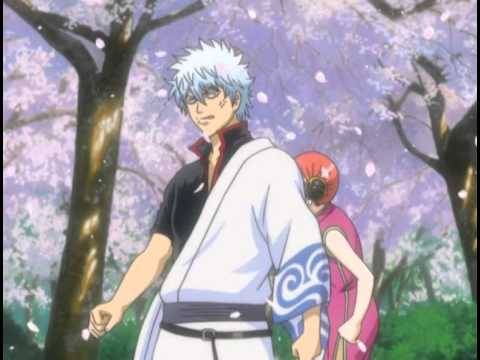
I still don’t know how this show wrangled such a spectacular OP out of its loosest, least focused stretch of episodes, but goddamn if they didn’t pull it off. It captures Gintama’s freewheeling spirit better than any OP, all the chaos and wonder and irreverent nonsense that you can’t help falling in love with. The massive character scroll as the chorus picks up and Gintoki’s run through the streets of Edo are better versions of Day x Day’s similar techniques, making you feel the vastness of this world without losing itself in the magnitude. Everyone gets a moment to shine, everyone feels important, and you come away ready to have fun with each and every idiot who showed their face.
7: Know Know Know (OP 17)

DOES, the band behind Donten, finally makes their grand return to the Gintama OP scene, and the result is the best version of everything they’ve done before. The intense rainy atmosphere is even more crushing and heavy, the song is even more striking and sinister, the action is even more explosive and brutal, and the weight of the collapsing world hangs over every single shot. This is an anthem for a world on fire, the perfect lead-in to the world of this show turning upside-down in the Farewell Shinsengumi arc. Like the song says, good time is now to break free of the past and carve out a future worth fighting for.
6: Sakura Mitsutsuki (OP 13)

Fucking hell, I really wish this one was higher. Spyair as a band captures the soul of Gintama better than anyone else; this song might legitimately be the best of them all, rousing and beautiful and blazing with hope and courage in the face of impossible odds. And the shining cherry blossoms against the almost green-tinged night sky make every single shot feel massive, befitting the upheaval of the Pinky Promise arc. Plus, that one shot of GIntoki running as the chorus kicks up? Might legitimately be the best version of *that* shot in any anime OP ever. But when you get this high in the rankings, you’re really going up against the best of the best, and five entries managed to even top this one.
5: Wonderland (OP 11)
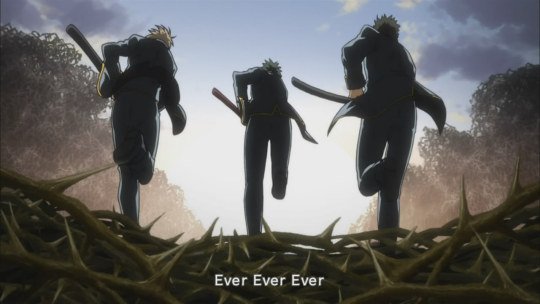
This is by far the best of the “classic” Gintama OPs, using all its tried and true imagery to its best possible effect. The character intros are all resonant as hell, the animation is killer across the board, the intensity of the Shinsengumi’s focus is palpable (especially that one shot of Hijikata stumbling through the thorns in his path as he grows up, gradually growing strong enough to leave them behind), and god damn is the song powerful. This is everything great about Gintama in a single, soulful package.
4: Kagerou (OP 18)
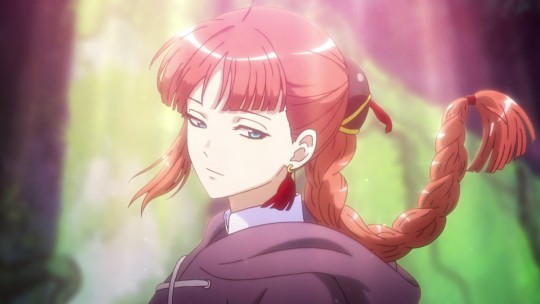
The Battle at Rakuyo is still far and away my favorite arc of the bunch, so thank god it had an equally smashing OP to match. This is by far the most explosive of the bunch; it’s nothing but sakuga upon sakuga, the editing and camerawork taking you through every stage of this immense battle with the energy or a firecracker. It soars and spins through battles and chaos, with the past and present overlapping and feeding into each other using the brilliant device of smoke plumes crossing the screen to bridge the temporal gap. That one device leans itself to so many fucking stellar sequences: the opening bit where the good old days of the past are contrasted with the terrifying, empty days of the present, Gintoki and his old friends fighting together side by side once more, Nobume’s gaze firmly set of the people who drive her forward... yeah, this one’s really stunning. And the song’s chaotic enough to match. Not to mention literally every scene with Kagura, racing forward into the fray to face her demons, grasping for the family just outside her reach. God, this arc was fucking amazing.
3: Dilemma (OP 10)

It’s kind of funny to look back on this OP and realize that the dark, brooding atmosphere it proported was nothing but a cover for some of the series’ goofiest, stupidest arcs of all time. But that doesn’t take away from what a majestic experience it remains all on its own. Soaked in noir atmosphere and backed by a haunting rock ballad, there’s a grandeur to this OP that makes you feel like you’re watching the entire world erupt in flames far below you, a mosaic pattern of beautiful chaos. And that one sequence where the shades of the women in Gintoki’s life all flash by him, flickers of people he can’t seem to shake... wow. Even knowing the true purpose behind that moment now, it’s goddamn riveting. Just count this OP is the single best lie Gintama has ever told (and that’s saying something).
2: Tougenkyou Alien (OP 9)

While there’s obviously one more OP that’s got this one beat for me, this is by far the best representative of what Gintama is. It captures its madcap, frenetic energy better than any other OP, the racing, driving, chaotic, ridiculous heartbeat of the entire damn show. The song is an utter banger, the editing makes every punchline stick the landing, everyone gets their moment in the sun (Kyubei riding a horse with their princess was a particularly inspired touch), and it just gets you pumped up as hell for the wacky ride you’re about to embark upon. Were I to introduce Gintama to a friend, this is the OP I would use to do it. God damn, is it a kicker. Also, that one time they screwed it up? Perfect.
1: I Wanna Be (OP 21)

I tried to think of an alternative, but in the end, I couldn’t justifying putting anything else in the top spot than the (as of now) final OP. It brings this story to a close and makes you feel the weight of every single moment you’ve spent with it, with little more than character panning shots and evocative, watercolor animation. The sun rising over the horizon in the opening shot sets the tone perfectly for an experience that feels like rebirth, like we’re finally shaking the dust off the old days and stepping into the new world we’ve been fighting for. And good fucking god, Spyair’s song here is a goddamn masterpiece of operatic emotionality. This is the end of a very long journey that makes every single step of the way feel like the most important step of your life, and I can’t think of a more deserving winner than something that so perfectly encapsulates why this show is so goddamn powerful.
#anime#the anime binge-watcher#tabw#gintama#sakata gintoki#gintoki sakata#shimura shinpachi#shinpachi shimura#kagura
22 notes
·
View notes
Audio
Gintama ED #17 | SPYAIR - Some Like It Hot!! [8-Bit Cover]
3 notes
·
View notes
Note
What's your favourite OP and ED for Gintama?
Oh yay this is an excellent question! I accidentally may have ended up listening to all of the first 17 OPs (while cleaning) to refresh my memory. I was hoping going through them again might change my answer to something original but:
Yeah my favorites are DOES: Donten for the intro and Shura for the ending. They are intrinsically linked to my Gintama experience - particularly the first time Sorachi put the story into shounen overdrive. Know Know Know is also excellent. Bonus: they are fantastic songs to do in karaoke, which is one of the standards by which I judge OPs and EDs.
Honorable mentions for OP:
Dish//’s Katte ni My Soul is fantastic. See above re: karaoke. You can really belt it out! And the lyrics match the current arc so well. Lots of love.
Serial TV Drama’s Tengoku Alien is probably the most intensely Gintama song ever and I love it.
Tommy’s Heavenly 6: Pray. The original. Nothing about the song or the animation could have been better suited to get me hooked on the show, and I will always be grateful for that.
Honorable mentions for ED:
Monobright's Moonwalk is so fun and upbeat and they totally wanted to get a call from the Space Brothers people but went for Gintama instead and I respect that.
Swimy’s Acchi Muite has harmonies and clapping and will teach you the eras from Meiji to Heisei and you really can’t beat that.
Burnout Syndromes’ Hana Ichi Monme is such a good song - definitely worth checking out the full version, which includes lines from the call-and-answer children’s game the song is named for - and I just adore the ending animation. For some reason it hit me really hard the first time I saw it and I imprinted on it in a major way.
(…oh man I almost forgot Spyair and the worst not-actually-a-homonym-or-pun-except-somehow-it-works-in-Japanese: Samurai Heart/Some Like It Hot. Also they are huge nerds who show up for the live events and are coming back to do the opening for the second half of the Silver Soul arc so I would feel bad not putting them on my list.)
Ahh, now I am so curious to know if this is the standard boring answer or if everyone has wildly different opinions on this? There’s so many to choose from come at me with your top picks!
9 notes
·
View notes
Text
Gintama endings, final poll
11 notes
·
View notes
Photo

Buon Martedì Amici della Non Solo Libri! Eccovi elencate le novità del giorno: CARTOON CLUB: - FUMO DI CHINA 310-311 EDIZIONI STAR COMICS: - ADOU 1 - CHILDREN OF THE WHALES 18 - DETECTIVE CONAN NEW EDITION 4 - GINTAMA 75 - JOJOLION 25 - MASHLE CREAM PUFF PACK - ONE PIECE NEW EDITION 90 - SHIRAYUKI DAI CAPELLI ROSSI 7 - SHAMAN KING FINAL EDITION 14 - SUMMER TIME RENDERING 13 - YOTSUBA &! 13 FLASHBOOK: - COSÌ COME SEI 3 LIZARD: - METALLICA THE BLACK ALBUM IN B&W LO SCARABEO: - SERPIERI E GLI ALTRI UNIVERSI PANINI COMICS: - BEASTARS 21 - BLEACH 45 - RISTAMPA - CABLE 2 - DEPRESSIONE - CARNAGE: BLACK, WHITE & BLOOD - CINEMA PURGATORIO MODDED - DEATH NOTE BLACK ED. 4-5-6 - RISTAMPA - DRIFTING DRAGONS 10 - FANTASTICI QUATTRO: L'ARRIVO DI GALACTUS - FULLMETAL ALCHEMIST DELUXE ED.5 - IL MIO DANNATO RIVALE 7 - I NUOVISSIMI X-MEN 97 - MARAUDERS 19 - I VIAGGI DELLA STREGA 3 - MARVEL INTERNATIONAL GLI INCREDIBILI X-MEN 34 - MUSHOKU TENSEI 4 - PK GIANT - GLI SPECIALI - PLANET OF THE FOOLS 1 - REAL 2 - RISTAMPA - RED EYES 24 - SPIDER-MAN L'ULTIMA CACCIA DI KRAVEN ( MUST HAVE ) - SING "YESTERDAY" FOR ME 9 - STAR WARS: L'ALTA REPUBBLICA 6 - THE KILLER INSIDE 9 - VAGABOND DELUXE 10 - RISTAMPA - WOLVERINE 417 - ZEBRA 22 PANINI COMICS - DC: - BATMAN/SUPERMAN 16 - BATMAN GUERRA AL CRIMINE - DC LIMITED - BATMAN:LA SPADA DI AZRAEL - IL GRANDE LIBRO DI CATWOMAN - JOKER 2 - DC CLASSIC - JUSTICE LEAGUE 17 - LA LEGA DELLA GIUSTIZIA D'AMERICA 2 - RORSCHACH 7 - SUPERMAN DI JOHN BYRNE 10 RW GOEN: - DELITTO E CASTIGO 7 - DEVILS AND REALIST 13 - FORZA GENKI! (FORZA SUGAR) 21 - HAKKENDEN 11 - UQ HOLDER! 19 - TEIICHI HIGH SCHOOL 13 - KARAKURI CIRCUS 35 - LOCKDOWN X SCHOOL 3 - LA VITA DI ODA SABURO NOBUNAGA 7 - MARUHAN IL MERCENARIO 6 - OGGI SONO IN FERIE 12 - SAVAGE GARDEN 5 (DI 7) - SAINT YOUNG MEN 18 SALDA PRESS: - BIRTHRIGHT 10 - CARTONATO E BROSSURATO - FEAR AGENT 1 SHOCKDOM: - DEFICIENTS&DRAGONS TREPONÈMA LA LEGGENDA DI FALLOPPIA VI ASPETTIAMO!!! #fumetterianonsololibri #fumetti #manga #comics #graphicnovel #funkopop (presso Non Solo Libri - Store) https://www.instagram.com/p/CVNbKFztlCj/?utm_medium=tumblr
1 note
·
View note
Photo
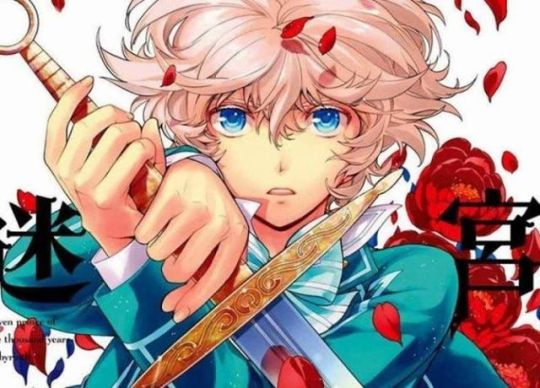
[Forum] Sorties mangas de avril 2018 Sorties de avril 2018 Mardi 03 avril 2018 L'Histoire en manga T.3 Simple (Guide) Bayard Jeunesse Mercredi 04 avril 2018 Bimbogami Ga ! T.16 Simple (Manga) Tonkam Cheeky love T.6 Simple (Manga) Delcourt / Tonkam Die & Retry T.4 Simple (Manga) Delcourt / Tonkam Dr.STONE T.1 Simple (Manga) Glénat Manga Fairy Tail S T.2 Simple (Manga) Pika Freezing T.31 Française (Manga) Doki-Doki GTO T.9 Édition 2017 (Manga) Pika Head Trick T.6 Réédition (Global manga) ED Edition Infection T.2 Simple (Manga) Delcourt / Tonkam Ken'en - Comme chien et singe T.1 Simple (Manga) Doki-Doki Kiss x Death T.5 Simple (Manga) Delcourt / Tonkam L'Attaque des Titans T.24 Limitée (Manga) Pika L'Attaque des Titans T.24 Simple (Manga) Pika La Courtisane d'Edo T.1 Simple (Manga) Pika Le fil du destin T.5 Simple (Manga) Panini manga Les 7 princes et le labyrinthe millénaire - Spin-off T.1 Simple (Manga) Doki-Doki One Piece T.86 Collector 20 ans (Manga) Glénat Manga One Piece T.86 Nouvelle Edition - Française (Manga) Glénat Manga Platinum End T.1 48h BD 2018 (Manga) Kazé Manga Re:Load T.2 Simple (Manga) Doki-Doki Re:teen T.1 Simple (Manga) Doki-Doki Rinne T.23 Simple (Manga) Kazé Manga Shôjo addict T.1 Simple (Magazine) Pika Takane & Hana T.9 Simple (Manga) Kazé Manga Takane & Hana T.9 Simple (Manga) Kazé Manga Tenjin T.1 48h BD 2018 (Manga) Kana To the Abandoned Sacred Beasts T.5 Simple (Manga) Pika To your eternity T.1 48h BD 2018 (Manga) Pika Toi, ma belle étoile T.1 Simple (Manga) nobi nobi! Twin star exorcists – Les Onmyôji Suprêmes T.13 Simple (Manga) Kazé Manga Waiting for spring T.1 Simple (Manga) Pika Wonder Rabbit Girl T.3 Simple (Manga) Delcourt / Tonkam World's End Harem T.1 Simple (Manga) Delcourt / Tonkam Young GTO ! T.8 Volumes doubles (Manga) Pika Yûna de la pension Yuragi T.2 Simple (Manga) Pika Jeudi 05 avril 2018 A Silent Voice T.1 Pack découverte (Manga) Ki-oon Black Torch T.2 Simple (Manga) Ki-oon Bride Stories T.1 Pack offre découverte (Manga) Ki-oon Darwin's Game T.1 Pack découverte (Manga) Ki-oon Final Fantasy - Lost Stranger T.1 Simple (Manga) Mana Books Golden Kamui T.10 Simple (Manga) Ki-oon Isabella Bird T.3 Simple (Manga) Ki-oon La Cantine de Minuit T.3 Simple (Manga) Le lézard noir Lyla et la bête qui voulait mourir T.2 Simple (Manga) Ki-oon Mimikaki T.1 Simple (Manga) Le lézard noir My Hero Academia T.13 Simple (Manga) Ki-oon Pandora Hearts T.1 Pack découverte (Manga) Ki-oon Re/member T.1 Pack découverte (Manga) Ki-oon Sous un ciel nouveau T.1 Simple (Manga) Ki-oon Vendredi 06 avril 2018 Doraemon T.42 Simple (Manga) Kana Gleipnir T.2 Simple (Manga) Kana La Légende du héros chasseur d'aigles T.5 Simple (Manhua) Urban china Le pavillon des hommes T.14 Simple (Manga) Kana Ryle & Louis T.2 Simple (Manga) Kana Short Love Stories T.6 Simple (Manga) Kana Tales of wedding rings T.1 Pack découverte (Manga) Kana Tales of wedding rings T.5 Simple (Manga) Kana Zettai Karen Children T.31 Simple (Manga) Kana Mercredi 11 avril 2018 Area 51 T.15 Simple (Manga) Casterman Manga Atomic (s)trip T.1 Simple (Manga) Pika Be-Twin you & me T.4 Simple (Manga) Soleil Manga Black Prince & White Prince T.6 Simple (Manga) Soleil Manga Blue Exorcist T.20 Simple (Manga) Kazé Manga Cat's Eye T.13 Nouvelle édition 2015 (Manga) Panini manga Dolly Kill Kill T.10 Simple (Manga) Pika Flying Witch T.6 Simple (Manga) nobi nobi! Haikyu !! Les As du Volley T.27 Française (Manga) Kazé Manga Kuhime T.2 Simple (Manga) Panini manga Le diable s'habille en soutane T.1 Simple (Manga) Soleil Manga Rain Man T.3 Simple (Manga) Panini manga Riku-do T.8 Simple (Manga) Kazé Manga Seven Deadly Sins T.26 Française (Manga) Pika Shinobi Quartet T.1 Simple (Manga) Pika Stravaganza - La Reine au Casque de Fer T.6 Simple (Manga) Casterman Manga Teach me love ! T.9 Simple (Manga) Soleil Manga The testament of sister new Devil - Storm! T.4 Simple (Manga) Delcourt / Tonkam Jeudi 12 avril 2018 Devil inside T.1 Simple (Manga) Komikku Editions Gift ± T.7 Simple (Manga) Komikku Editions Ippo T.13 Saison 5 : Dans l'ombre du champion (Manga) Kurokawa Kenichi - Le Disciple Ultime T.21 Saison 2 (Manga) Kurokawa Log Horizon T.4 Simple (Light novel) Ofelbe Magi - The Labyrinth of Magic T.28 Française (Manga) Kurokawa Prisonnier Riku T.26 Simple (Manga) Akata Red Eyes Sword - Akame ga Kill ! T.15 Simple (Manga) Kurokawa Renjoh Desperado T.1 Simple (Manga) Kurokawa Saltiness T.1 Simple (Manga) Akata Shonan seven T.8 Simple (Manga) Kurokawa Silencer T.1 Simple (Manga) Komikku Editions Silver Wolf Blood Bone T.2 Simple (Manga) Kurokawa Soul Eater T.5 Volumes doubles (Manga) Kurokawa Soul guardians T.2 Simple (Manga) Komikku Editions Mercredi 18 avril 2018 Ajin T.11 Simple (Manga) Glénat Manga Alice in Murderland T.8 Simple (Manga) Pika Card Captor Sakura T.1 Edition 2017 (Manga) Pika Card Captor Sakura T.2 Edition 2017 (Manga) Pika Chocotan T.3 Simple (Manga) nobi nobi! Close to Heaven T.4 Simple (Manga) Pika Dragon Ball Forever T.1 Simple (Guide) Glénat Manga Freaky girls T.5 Simple (Manga) Pika Fruits Basket T.5 Perfect (Manga) Delcourt / Tonkam Fruits Basket T.6 Perfect (Manga) Delcourt / Tonkam Gantz T.10 Perfect (Manga) Delcourt / Tonkam Hana Nochi Hare - Hanadan Next Season T.1 Simple (Manga) Glénat Manga Happiness T.2 Simple (Manga) Pika Hitokui T.8 Simple (Manga) Panini manga Le journal de Kanoko - Années lycée T.8 Simple (Manga) Pika Les Brigades Immunitaires T.5 Simple (Manga) Pika Lovely Fridays T.9 Simple (Manga) Tonkam Magical Dance T.2 Simple (Manga) nobi nobi! Magical task force Asuka T.1 Simple (Manga) Pika Online The comic T.7 Simple (Manga) Delcourt Manga Parmi Eux - Hanakimi T.11 Deluxe Française (Manga) Tonkam Parmi Eux - Hanakimi T.25 Simple (Manga) Tonkam Ranma 1/2 T.3 Ultimate (Manga) Glénat Manga Un pigeon à Paris T.2 Simple (Manga) Glénat Manga Yona, Princesse de l'aube T.23 Simple (Manga) Pika Jeudi 19 avril 2018 A l'intérieur des yokaï T.1 Simple (Guide) Cornelius Manga Awaken T.8 Simple (Manga) Ki-oon Bride Stories T.10 Latitudes (Manga) Ki-oon Bride Stories T.10 Française (Manga) Ki-oon Dragon Seekers T.6 Simple (Manga) Komikku Editions Hanada le garnement T.4 Simple (Manga) Ki-oon Le Requiem du Roi des Roses T.8 Simple (Manga) Ki-oon Lockdown T.8 Simple (Manga) Ki-oon Monkey Peak T.2 Simple (Manga) Komikku Editions Pétales de réincarnation T.7 Simple (Manga) Komikku Editions Roji ! T.11 Simple (Manga) Ki-oon Souvenirs de la mer assoupie T.1 Simple (Manga) Imho Vendredi 20 avril 2018 Après la pluie T.5 Française (Manga) Kana Dan Machi T.4 Simple (Manga) Ototo Manga Dark Grimoire T.1 Simple (Manga) Kana Fate/Apocrypha T.3 Simple (Manga) Ototo Manga Fire force T.6 Simple (Manga) Kana Gate - Au-delà de la porte T.8 Française (Manga) Ototo Manga Gintama T.49 Simple (Manga) Kana I am a Hero T.22 Française (Manga) Kana Levius est T.4 Simple (Manga) Kana Otaku Otaku T.1 Simple (Manga) Kana Shirayuki aux cheveux rouges T.17 Simple (Manga) Kana Sword Art Online - Girls Ops T.2 Simple (Manga) Ototo Manga The grim reaper and an argent cavalier T.4 Simple (Manga) Kana Lundi 23 avril 2018 Urotsukidôji T.1 Simple (Manga) Black box Mercredi 25 avril 2018 Blue T.0 simple 2018 (Manga) Casterman Manga Dino Sapiens T.1 Simple (Manga) Soleil Manga I love you so I kill you T.2 Simple (Manga) Soleil Manga Lovely Love Lie T.20 Simple (Manga) Soleil Manga Prison School T.16 Simple (Manga) Soleil Manga Rainbow Days T.14 Simple (Manga) Kazé Manga The promised Neverland T.1 Simple (Manga) Kazé Manga Yo-kai watch T.9 Simple (Manga) Kazé Manga Jeudi 26 avril 2018 Anne et la Maison aux Pignons Verts T.2 Simple (Manga) ISAN Manga Bi no Kyoujin: Smoke T.1 Simple (Manga) Taifu Comics Brother Auto Spot T.1 Simple (Manga) Taifu Comics DanMachi – La légende des Familias T.6 Simple (Light novel) Ofelbe Good Morning Little Briar-Rose T.4 Simple (Manga) Akata Inspecteur Kurokôchi T.17 Simple (Manga) Komikku Editions La Perspective T.1 Simple (Méthode) Euromanga Edizioni La petite fille aux allumettes T.6 Simple (Manga) Komikku Editions Le Chef de Nobunaga T.19 Simple (Manga) Komikku Editions Le disciple de Doraku T.4 Simple (Manga) ISAN Manga Le secret de l'ange T.1 Simple (Manga) Akata Magical Girl of the End T.15 Simple (Manga) Akata Mises à nu T.2 Simple (Manga) Taifu Comics Rising sun T.13 Simple (Manga) Komikku Editions Lien vers la fiche : https://ift.tt/2EfqcyY https://ift.tt/2pYJfIt
3 notes
·
View notes